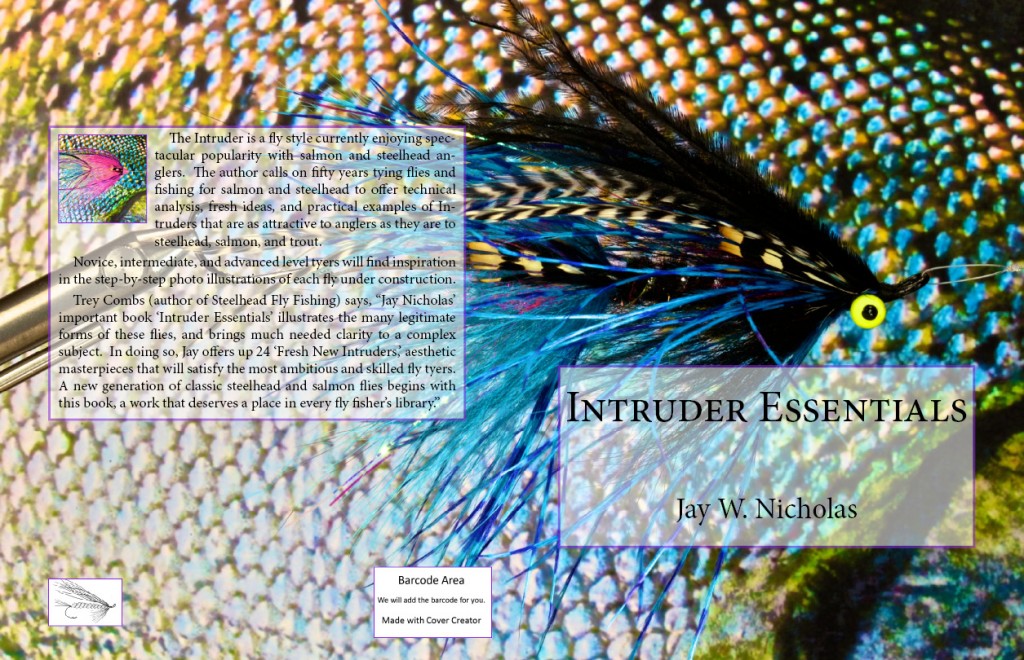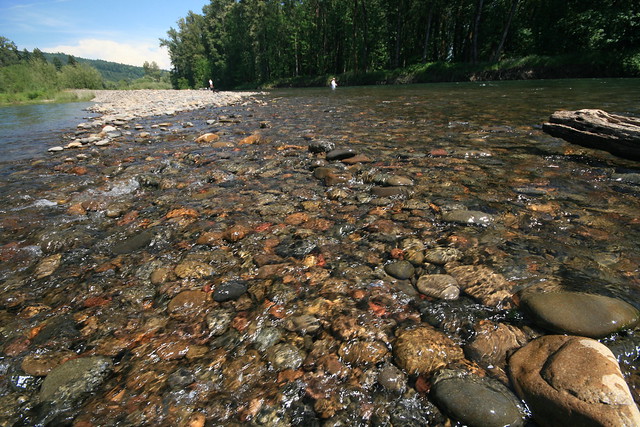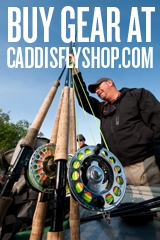George Cook our Rio Fly Line representative has been a leader in design and explanation of everything spey in the Pacific Northwest for years. If you have ever attended a class or “clave” with George you most likely will remember it. His unique nomenclature is memorable and enjoyable. Below you will find George’s latest explanations of sink tips and their uses. Thanks George great stuff as usual!
For a good decade (1993 thru the early 2000 period) the conventional (Now Traditional) 15’ sink tip was the “Tip Of The day” so to speak. Here the angler was typically armed with an array of 15’ Sink Tips in Type 3, 6, 8 and even a clear version Intermediate. Both Single Hand as well as Spey Anglers employed their use plying waters from Alaska to Tierra Del Fuego. Such tips, particularly in the Type 6 and 8 sink rates were extremely common in the Pacific Northwest. Such popularity was well deserved and fully earned as these sink Tips (The Brainchild of RIO Founder Jim Vincent) were simply indispensable be it winter or summer assignment. The beauty of these 15’ tips was that they cast extremely well and play wonderfully throughout the Steelhead range of the west coast. In this, the classic and beautiful gliding runs from the Rogue to the Babine and all points in between were covered by single hand (Versi Tip Line sets) and spey anglers alike, (Windcutter and Skagit lines of era). The selection of these tips by the Steelhead and at times the King enthusiast, was well thought out on any given run. The study of a given run (Head/Body/Tail out) closely coincided with just how these tips would play out in such waters and the education/selection/use understanding was well under way. Available in various Grain weights from 95-190 with the #9 (129 Grain) and 150 grain (#10 Weight) leading the way these tips while not as popular today these still have their place in every anglers shooting head wallet.
15’ Intermediate Tip
Use: The sleeper tip in your wallet. The intermediate has a reputation as a “Slicer/Wind Cutter” that can and will serve the summer angler well from dawn to mid-morning even during the day as it provides what I like to call slicer line speed that often makes the difference on a turned over fly on such haunts as Oregon’s Deschutes or Idaho’s Clearwater (Same goes for an Intermediate Spey-Freshwater Versi-leader used on a Scandi style line).
15’ Type 3
Often overlooked but has a distinctive place in the Steelheaders wallet with Silver Salmon use as well. The obvious use is classic tail out scenarios both winter, and summer; unobvious use is for what we lovingly call “Frog water” which many of these Pacific Northwest Rivers have and Big Ol’ Late winter Runs have a penchant for hanging in. These often “Given Up On” portions of bottom end runs can hold Big Nasty Steelie Bucks that can only be swung up with lesser sink tip or MOW type animal. Anything beyond a Type 3 (3.0 ips /inches per second sink rate) sink tip is simply too much, dragging bottom and out of the game.
15’ Type 6
A Longtime, prime time sink tip player. To be sure, loads of Steelhead and Kings have been subdued with these 6.0 ips tips. When in doubt upon arriving courtside on a classic northwest Steelhead run string up a 150 grain (#10) 15’ type 6 sink tip and proceed with CONFIDENCE. Truly a tip to not be missed as it will serve one well in the global spey theater.
15’ Type 8
7.0 ips provides for high line speed charged cast coupled with a sink rate that has become the new standard in historical 15’ tips. #9 @129 Grain along with the vaunted 150 Grain (#10) are the go to players here. Long classic glide runs are possibly the foremost targets with these tips.
The Genius of RIO’s Skagit MOW and iMOW Tips
Originally brought forth by the “3 Speyketeers” as I call them, Mike McCune/Scott O’Donnell and Ed Ward (Hence the name MOW…McCune-O’Donnell-Ward). The MOW System is nothing short of brilliant!
Available in Light (T-8 format 7.0 ips), Medium (T-11, 8.0 ips), Heavy (T-14 format @9.0 ips) and Extra Heavy (T-17, 10.0 ips) .
Each MOW Family (Series) has 6 “Family Members” consisting of the following:
10’ Floating Tip
10’ Sinking Tip
12.5” Sinking Tip
THEN….the 3 MOW’s…..7.5 x 2.5 (7.5 Floating integrated into 2.5 of given make up say medium as an example in T-11). 2nd MOW is a 5 x 5 (5’ of Floating integrated into 5’ on sinking).MOW #3 is a 2.5 x 7.5 (2.5 of Floating Integrated into 7.5 of sinking).
There are two ways to get these 6 family members, either individually or in a MOW Kit (Say, a MOW Medium Kit as an example).
Practical Usages as prescribed below….
10’ Floating Tip : The MOW system is built for use with Skagit Style Spey Lines . Regardless of Skagit “Type” (RIO formula’s include Max Short/Max & Max Long) the MOW’s are formulated to play in the Skagit line theater. The 10’ Floating Tip is a quick way to “Ala Carte” your Skagit Line into a Full Floating use line.
10’ and 12.5’ Sink Tips: Available throughout the MOW Range (Light/Medium/Heavy/EX Heavy), these practical length sink tips play incredibly well with a wide range of Spey and switch rods making them a wonderful addition to the standard “Traditional” 15’ sink tips (Intermediate/Type 3, 6 and Type 8). These 2 sink tips will provide the Angler with sink rates from 7.0 ips (Light T-8) all the way to 10.0 ips (EX Heavy T-17)that will cover a wide range of use from Alaskan Kings to Tierra Del Fuego Sea Run Browns as well as the full gamut of Steelhead application.
The 3 True MOW’s
Here is where the absolute Genius of the MOW boys shines brightest ! Given that any “Cut” sink tip under 9’ is likely going to basically become a boomerang/tumbler within the cast that will prove to be ugly at best and ultra frustrating at worst. The “Integration Format” that McCune/Scotty O and Ed brought to the table from their “Chop Shop” artistry days providing the stability/cast-ability of a 10’ common denominator in overall length coupled with the desirable “Baby Tips” making for one of the all time great innovations.
7.5 x 2.5 (2.5 being the Sinking Portion): True “Rock Garden/Tail Out Probe Tool”. One could think of a 15’ Type 3 in this instance but the beauty of the MOW idea/format is that the mere 2.5 sinking portion is simply unrivaled when it comes to sliding around and thru such haunts. The traditional 15’ sink tip or even the 10’ and 12.5” MOW Sink Tip family members are all prone to “Swing Drag Thru” often catching/hanging up and killing any real chance at a follow and/or GRAB.
5 x5 (5’ Floating with 5’ Sinking): Again, another Rock Garden probe but long enough to provide quick drop for given slots particularly in ledge rock environments found in many Steelhead streams. The 5 x 5 MOW Heavy (T-14 Format) is a great one for such a task where the angler needs a quick drop into a slot where he’ll need to engage quickly in order to be in that zone/slot target area. Lots of Pacific Northwest watersheds feature just such places making the 5 x 5 MOW a handy tool.
2.5 x 7.5 (7.5 being the sinking portion): My personal favorite in both the standard MOW as well as IMOW (See Below). This “Baby Tip” if you will has tons of application for a host of fisheries most certainly including the trout game. Given water depth and speed considerations often play perfectly into the hands of the 2.5 x 7.5 MOW quite often in the MOW Medium (T-11) format. Incredibly versatile sliding thru the boulders and swinging “All The way In” giving both “The Long Followers and The Down Below You” Critters time and opportunity to run down or run into your swung offering.
iMOW Family
The innovation of the Intermediate style Skagit Heads necessitated the invention of the iMOW sink tip in order to accommodate MOW usage with such an Intermediate format head (Substituting Integrated Intermediate VS Floating as found in the original MOW format), this is the obvious use of an iMOW but certainly not limited to an iFlight/IMAX format line. I personally love the iMOW’s, as a general MOW use tool as they can, and do have their place covering a host of angling waters particularly where you know going in, that the bottom format is relatively clean but needing “Less” of a given sink tip. iMOW’s come in LIGHT/Medium and Heavy. Kits have 6 family members with the previously mentioned 10’ floating Tip subbed out for a 10’ Intermediate tip.
iMOW Family:
10’ Intermediate Tip
10’ Sink Tip
12.5” Sinking Tip
The 3 iMOW’s
7.5 x 2.5 (7.5 is intermediate integrated to 2.5 of given sink tip say iMOW Heavy T-14 as an example)
5 x 5 IMOW
2.5 x 7.5 IMOW
Al in all, the MOW Families have a lot to offer the Spey and Switch Rod enthusiast. I can tell you with absolute confidence that every angler out there has/knows places that are “Made To Order” for MOW use, in particular the 3 True MOW tips. The Spey community owes a lot to the genius of the “3 Speyketeers “ Mike Mc Cune, Scott O’Donnell and Ed Ward.
George Cook













































